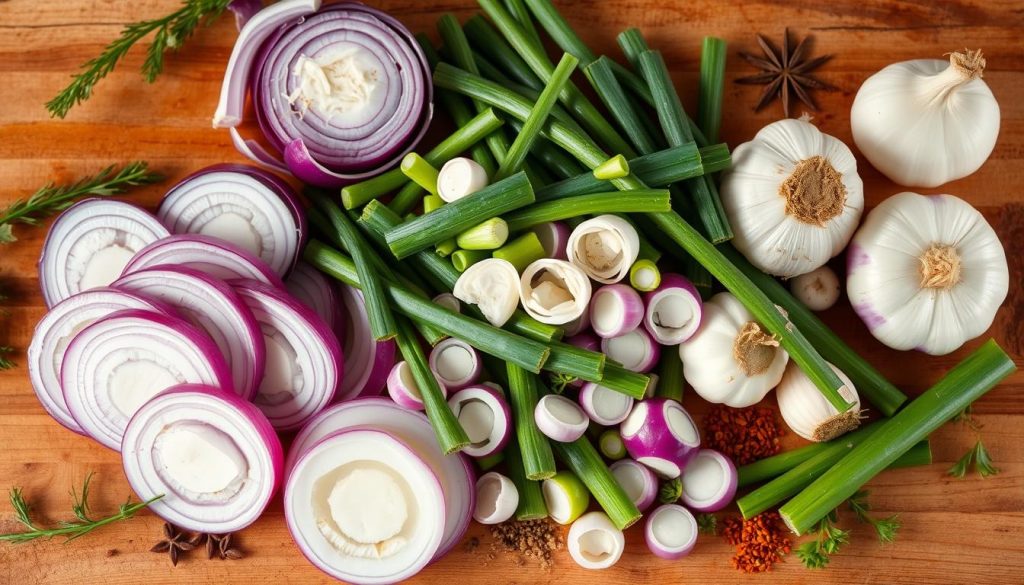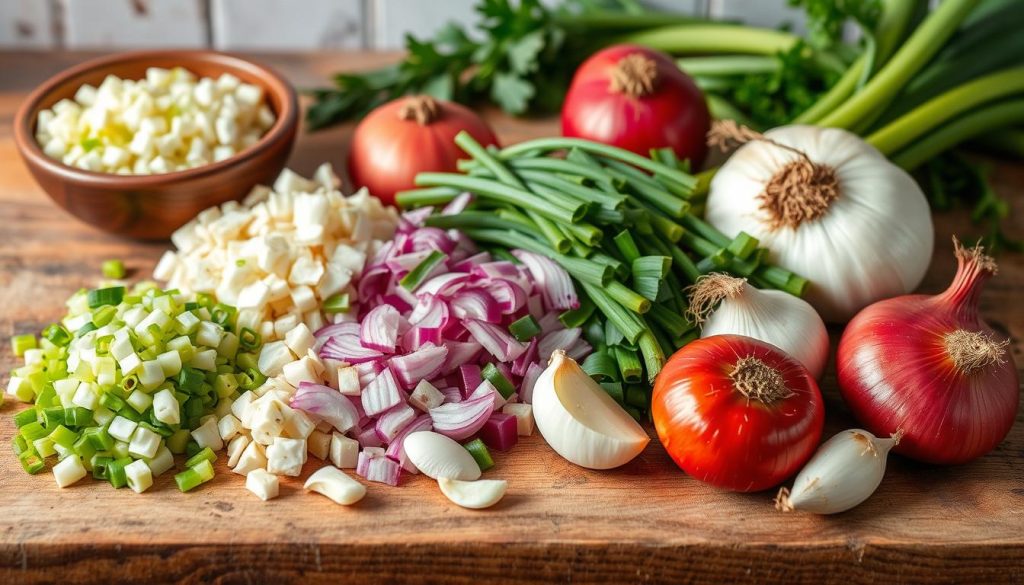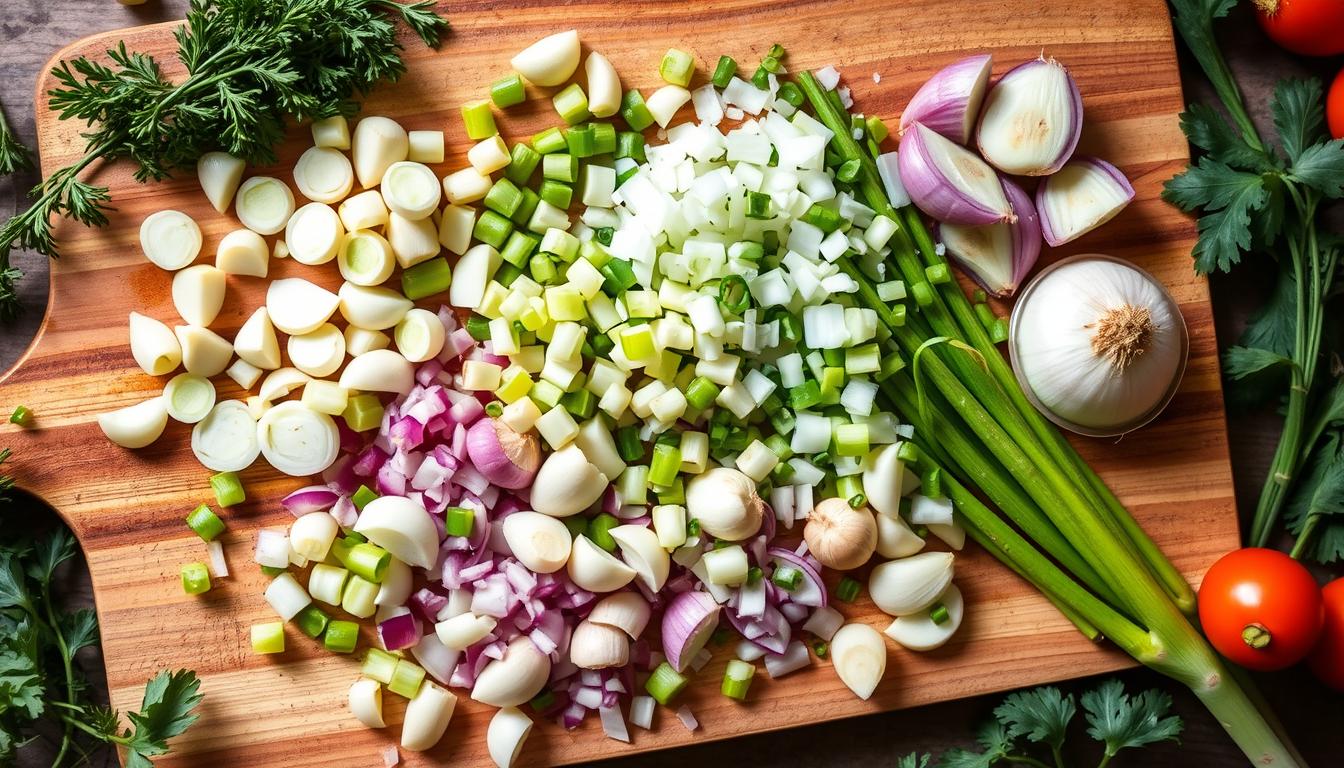Welcome to your go-to resource for yellow onion substitutes. On average, people use onions in cooking 5-7 times a week. They are a kitchen staple that you can’t afford to overlook.
Yellow onions are known for their strong pungent flavor. They are often called all-purpose onions. They are versatile in many recipes.
Sometimes, you might need a cooking substitute. This could be due to dietary restrictions, ingredient unavailability, or a desire to try new flavors. This guide will explore the characteristics and uses of yellow onions.
We will also look at various onion substitutes. Plus, we’ll give you practical tips for enhancing flavors in your dishes.
Understanding Yellow Onions
Yellow onions are a key ingredient in many kitchens. They have a strong flavor and are versatile in cooking. When cooked, they add sweetness due to their high sugar content. This makes them great for soups and stews, adding depth to any dish.
Characteristics of Yellow Onions
Yellow onions are unique among onions. They have a bold flavor, making them good for many cooking methods. Here are some key points:
- Flavor: Bolder than white onions, yellow onions have a strong taste that shines in cooked dishes.
- Sugar Content: Some types, like Vidalia or Maui, have more sugar, which adds sweetness.
- Cooking Integrity: Yellow onions keep their shape when cooked, perfect for recipes that need longer cooking times.
- Usage: About 90% of onions grown in the United States are yellow, thanks to their use in many cuisines.
Common Uses in Recipes
Yellow onions are great for many recipes. They are versatile and can be used in various dishes. Here are some common ways to use yellow onions:
- Sautéing: Perfect for stir-fries and pizza toppings, where you want a strong onion flavor.
- Soups and Stocks: Yellow onions are best for stocks and broths because they add a golden color and rich taste.
- Caramelizing: Their natural sugars caramelize well, making them sweet additions to sandwiches and burgers.
- Casseroles and Roasts: Their flavor stays strong during long cooking, making them key in baked dishes.
Using yellow onions in your cooking can add rich flavors and textures. They are a valuable ingredient in many meals.
Why Substitute Yellow Onions?
There are many reasons to swap out yellow onions. You might need them for a recipe or have dietary restrictions. For those allergic to the allium family, finding a substitute is crucial. Sometimes, onions can overpower a dish, so a milder option is needed.
Common Situations Requiring Substitution
Here are some common reasons to use onion alternatives:
- Running out of yellow onions unexpectedly
- Allergies or dietary restrictions against alliums
- Looking for a different taste to match a recipe
- Prefer a milder or sweeter flavor
Flavor and Texture Considerations
When cooking without yellow onions, think about the dish’s flavor and texture. Yellow onions have a unique taste that’s both sweet and pungent. They’re great for many recipes.
Choosing a substitute, remember each onion has its own taste. White onions are sharp and good for fresh dishes. Red onions add sweetness to salads without overpowering them. Sweet onions, like Vidalia, are milder and less pungent, perfect for many meals.

Top Alternatives for Yellow Onions
Looking for something other than yellow onions? There are many options with unique flavors and textures. Each one can change the taste of your dish, making it just right for you.
Leeks: A Versatile Option
Leeks are great if you want a milder taste. They work well in many dishes without overpowering them. You can swap one medium onion for one large leek. Try them in soups, stews, or sautés for a hint of sweetness.
Shallots: Mild Flavor for Delicate Dishes
Shallots are perfect for sauces and salad dressings because of their sweet taste. Use two large shallots for one medium onion. They add a refined flavor that won’t take over your dish, making them great for fancy recipes.
White Onions: Pungent and Crisp
White onions have a sharper taste than yellow onions. They’re great for Mexican or Asian dishes. Use them raw or cooked, and they’re a 1:1 substitute for yellow onions.
Sweet Onions: For a Milder Taste
Sweet onions, like Vidalia or Walla Walla, have a milder taste. They’re perfect for salads and sandwiches. Cooked, they add sweetness to dishes. You can use them in the same amount as yellow onions, adding a nice flavor without drying out your food.

Choosing the Right Substitute
Choosing the right onion substitute can really boost your dish’s taste. It’s important to know the flavor profiles needed for your cooking. For dishes that need a strong onion taste, red onions are a good pick. They have a sharper flavor.
For dishes that need a softer onion taste, shallots or leeks are great. They have a milder flavor.
Match the Flavor Profile to Your Dish
Think about the flavor balance of your meal when picking onion substitutes. For dishes with bold flavors, red onions work well. They can handle strong ingredients.
For dishes that are more delicate, shallots or white onions are better. They add a subtle taste.
Consider Cooking Methods
The cooking method affects your onion substitute choice. Sweet onions are good for sautéing. They add depth without overpowering the dish.
For slow-cooked meals, choose sturdier onions. They keep their texture well. Green onions add fresh, herbaceous notes to the final dish.
Adjusting Quantities: A Guide
When adjusting onion quantities, remember to keep proportions in mind. A small onion is about 1/3 cup chopped. Replace it with 1 teaspoon of onion powder or 1 tablespoon of dried onion flakes.
A medium onion is about 1 cup chopped. Use 1 tablespoon of onion powder or 3 tablespoons of dried onion flakes. A large onion is about 1.5 cups. Use 1.5 tablespoons of onion powder or 4.5 tablespoons of dried flakes.
| Onion Size | Chopped Yield | Onion Powder Substitute | Dried Onion Flakes Substitute |
|---|---|---|---|
| Small Onion | 1/3 cup | 1 teaspoon | 1 tablespoon |
| Medium Onion | 1 cup | 1 tablespoon | 3 tablespoons |
| Large Onion | 1 1/2 cups | 1 1/2 tablespoons | 4 1/2 tablespoons |
Yellow Onion Substitute Guide: Tips for Cooking Without Onions
Cooking without onions can be tricky, but many herbs and veggies can add flavor and texture. They help keep your dishes tasty, even if you can’t use onions. Here, you’ll find tips to cook delicious meals without onions.
Herbs and Spices as Alternate Flavor Enhancers
Herbs and spices can make your food taste great without onions. Garlic, fennel, and celery add depth to stews and stocks. Chives have a mild onion taste with a hint of garlic, making them a good choice for those who can’t eat onions.
Asafoetida powder is another great option. It adds flavor without the bad effects of onions. Just add a pinch to hot oil or fat before mixing in other spices.
Combining Vegetables for Texture and Flavor
Using different veggies can add flavor and texture when you don’t have onions. Bell peppers and carrots can give a crunchy sweetness. Napa cabbage and bok choy add a sulfury taste, while baby bok choy is great in veggie burgers and falafels.
Fennel’s complex flavor is also a good substitute. It adds a mildly pungent taste to meals. These veggies help make your dishes savory and flavorful.
| Substitute | Flavor Notes | Recommended Uses |
|---|---|---|
| Garlic | Pungent, savory | Stocks, sauces |
| Fennel | Mildly pungent, sweet | Soups, roasts |
| Celery | Crisp, fresh | Salads, stir-fries |
| Chives | Mild onion-like | Garnishes, spreads |
| Asafoetida | Strong, garlicky | Curries, dals |
| Bok Choy | Mild, slightly sweet | Stir-fries, soups |
Conclusion
Learning about onion substitutes can make you a better cook. This guide showed you options like leeks, shallots, white onions, and sweet onions. These alternatives let you change recipes based on what you have or what you like.
Each substitute has its own taste and texture. This means you can still make great food without yellow onions.
Think about how you cook and what you want your food to taste like. For example, red onions are great raw in salads. Sweet onions are perfect for caramelizing.
By using these substitutes, every meal can be full of flavor, even without yellow onions.
This guide has given you tips and info on onion substitutes. Adding these to your cooking can lead to many tasty dishes. Try out these options and you might discover new favorites. This way, you can make your cooking even better with a variety of onion substitutes.
Source Links
- https://www.gettystewart.com/onion-varieties-dont-right-type/
- https://food-hacks.wonderhowto.com/how-to/ultimate-onion-cheat-sheet-which-onion-goes-best-with-what-0150676/
- https://www.alsothecrumbsplease.com/best-substitute-for-onion/
- https://www.simplyrecipes.com/yellow-onion-vs-white-onion-8363941
- https://www.forksoverknives.com/how-tos/cooks-guide-onions-types-uses/
- https://www.seriouseats.com/yellow-onion-vs-white-onion-8666582
- https://thecookingdish.com/0330/the-difference-between-yellow-onions-white-onions-and-red-onions/
- https://www.simplyrecipes.com/red-onion-vs-yellow-onion-8403835
- https://thestonesoup.com/onion-substitutes/
- https://www.acouplecooks.com/onion-substitute/
- https://www.hungryhuy.com/onion-substitutes/
- https://www.bonappetit.com/story/types-of-onions-what-theyre-best-for?srsltid=AfmBOoqEwOx5wflwbUf6wLpWS4cQcWBOtSYNpiJMxRumEUV_siwewuvg
- https://www.thespruceeats.com/chopped-onion-substitutes-4150417
- https://alittlebityummy.com/blog/how-to-replace-onion-on-the-low-fodmap-diet/
- https://positivepranic.com/garlic-and-onion-substitute/
- https://www.seriouseats.com/differences-between-onions
- https://discover.texasrealfood.com/swap-and-savor/how-to-substitute-red-onion-for-yellow-onion
- https://medium.com/@labuloolawunmi/white-onions-red-onions-and-yellow-onions-is-there-any-difference-c07711e69ea4
- https://extension.uga.edu/publications/detail.html?number=B1198&title=onion-production-guide
